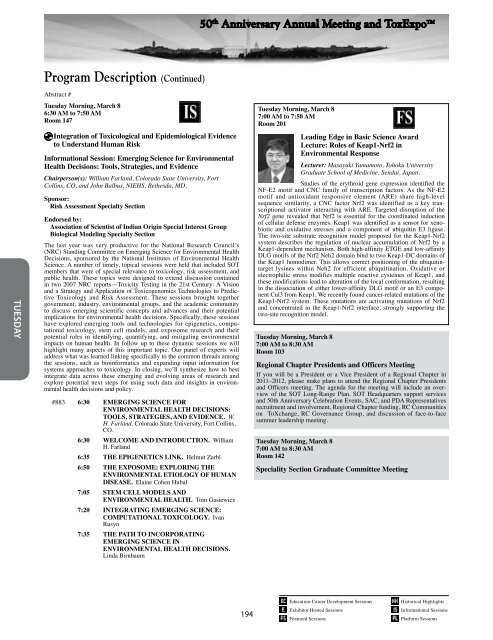Program - Society of Toxicology
Program - Society of Toxicology
Program - Society of Toxicology
You also want an ePaper? Increase the reach of your titles
YUMPU automatically turns print PDFs into web optimized ePapers that Google loves.
50 th Anniversary Annual Meeting and ToxExpo<br />
<strong>Program</strong> Description (Continued)<br />
Tuesday<br />
Abstract # Abstract #<br />
Tuesday Morning, March 8<br />
6:30 AM to 7:50 AM<br />
Room 147<br />
Integration <strong>of</strong> Toxicological and Epidemiological Evidence<br />
to Understand Human Risk<br />
Informational Session: Emerging Science for Environmental<br />
Health Decisions: Tools, Strategies, and Evidence<br />
Chairperson(s): William Farland, Colorado State University, Fort<br />
Collins, CO, and John Balbus, NIEHS, Bethesda, MD.<br />
Sponsor:<br />
Risk Assessment Specialty Section<br />
Endorsed by:<br />
Association <strong>of</strong> Scientist <strong>of</strong> Indian Origin Special Interest Group<br />
Biological Modeling Specialty Section<br />
The last year was very productive for the National Research Council’s<br />
(NRC) Standing Committee on Emerging Science for Environmental Health<br />
Decisions, sponsored by the National Institutes <strong>of</strong> Environmental Health<br />
Science. A number <strong>of</strong> timely, topical sessions were held that included SOT<br />
members that were <strong>of</strong> special relevance to toxicology, risk assessment, and<br />
public health. These topics were designed to extend discussion contained<br />
in two 2007 NRC reports—Toxicity Testing in the 21st Century: A Vision<br />
and a Strategy and Application <strong>of</strong> Toxicogenomics Technologies to Predictive<br />
<strong>Toxicology</strong> and Risk Assessment. These sessions brought together<br />
government, industry, environmental groups, and the academic community<br />
to discuss emerging scientific concepts and advances and their potential<br />
implications for environmental health decisions. Specifically, these sessions<br />
have explored emerging tools and technologies for epigenetics, computational<br />
toxicology, stem cell models, and exposome research and their<br />
potential roles in identifying, quantifying, and mitigating environmental<br />
impacts on human health. In follow up to these dynamic sessions we will<br />
highlight many aspects <strong>of</strong> this important topic. Our panel <strong>of</strong> experts will<br />
address what was learned linking specifically to the common threads among<br />
the sessions, such as bioinformatics and expanding input information for<br />
systems approaches to toxicology. In closing, we’ll synthesize how to best<br />
integrate data across these emerging and evolving areas <strong>of</strong> research and<br />
explore potential next steps for using such data and insights in environmental<br />
health decisions and policy.<br />
#883 6:30 EMERGING SCIENCE FOR<br />
ENVIRONMENTAL HEALTH DECISIONS:<br />
TOOLS, STRATEGIES, AND EVIDENCE. W.<br />
H. Farland. Colorado State University, Fort Collins,<br />
CO.<br />
6:30 WELCOME AND INTRODUCTION. William<br />
H. Farland<br />
6:35 THE EPIGENETICS LINK. Helmut Zarbl<br />
6:50 THE EXPOSOME: EXPLORING THE<br />
ENVIRONMENTAL ETIOLOGY OF HUMAN<br />
DISEASE. Elaine Cohen Hubal<br />
7:05 STEM CELL MODELS AND<br />
ENVIRONMENTAL HEALTH. Tom Gasiewicz<br />
7:20 INTEGRATING EMERGING SCIENCE:<br />
COMPUTATIONAL TOXICOLOGY. Ivan<br />
Rusyn<br />
7:35 THE PATH TO INCORPORATING<br />
EMERGING SCIENCE IN<br />
ENVIRONMENTAL HEALTH DECISIONS. <br />
Linda Birnbaum<br />
Tuesday Morning, March 8<br />
7:00 AM to 7:50 AM<br />
Room 201<br />
Leading Edge in Basic Science Award<br />
Lecture: Roles <strong>of</strong> Keap1-Nrf2 in<br />
Environmental Response<br />
Lecturer: Masayuki Yamamoto, Tohoku University<br />
Graduate School <strong>of</strong> Medicine, Sendai, Japan.<br />
Studies <strong>of</strong> the erythroid gene expression identified the<br />
NF-E2 motif and CNC family <strong>of</strong> transcription factors. As the NF-E2<br />
motif and antioxidant responsive element (ARE) share high-level<br />
sequence similarity, a CNC factor Nrf2 was identified as a key transcriptional<br />
activator interacting with ARE. Targeted disruption <strong>of</strong> the<br />
Nrf2 gene revealed that Nrf2 is essential for the coordinated induction<br />
<strong>of</strong> cellular defense enzymes. Keap1 was identified as a sensor for xenobiotic<br />
and oxidative stresses and a component <strong>of</strong> ubiquitin E3 ligase.<br />
The two-site substrate recognition model proposed for the Keap1-Nrf2<br />
system describes the regulation <strong>of</strong> nuclear accumulation <strong>of</strong> Nrf2 by a<br />
Keap1-dependent mechanism. Both high-affinity ETGE and low-affinity<br />
DLG motifs <strong>of</strong> the Nrf2 Neh2 domain bind to two Keap1-DC domains <strong>of</strong><br />
the Keap1 homodimer. This allows correct positioning <strong>of</strong> the ubiquitintarget<br />
lysines within Neh2 for efficient ubiquitination. Oxidative or<br />
electrophilic stress modifies multiple reactive cysteines <strong>of</strong> Keap1, and<br />
these modifications lead to alteration <strong>of</strong> the local conformation, resulting<br />
in the dissociation <strong>of</strong> either lower-affinity DLG motif or an E3 component<br />
Cul3 from Keap1. We recently found cancer-related mutations <strong>of</strong> the<br />
Keap1-Nrf2 system. These mutations are activating mutations <strong>of</strong> Nrf2<br />
and concentrated in the Keap1-Nrf2 interface, strongly supporting the<br />
two-site recognition model.<br />
Tuesday Morning, March 8<br />
7:00 AM to 8:30 AM<br />
Room 103<br />
Regional Chapter Presidents and Officers Meeting<br />
If you will be a President or a Vice President <strong>of</strong> a Regional Chapter in<br />
2011–2012, please make plans to attend the Regional Chapter Presidents<br />
and Officers meeting. The agenda for the meeting will include an overview<br />
<strong>of</strong> the SOT Long-Range Plan. SOT Headquarters support services<br />
and 50th Anniversary Celebration Events, SAC, and PDA Representatives<br />
recruitment and involvement, Regional Chapter funding, RC Communities<br />
on ToXchange, RC Governance Group, and discussion <strong>of</strong> face-to-face<br />
summer leadership meeting.<br />
Tuesday Morning, March 8<br />
7:00 AM to 8:30 AM<br />
Room 142<br />
Speciality Section Graduate Committee Meeting<br />
194<br />
Education-Career Development Sessions<br />
Exhibitor Hosted Sessions<br />
Featured Sessions<br />
Historical Highlights<br />
Informational Sessions<br />
Platform Sessions
















